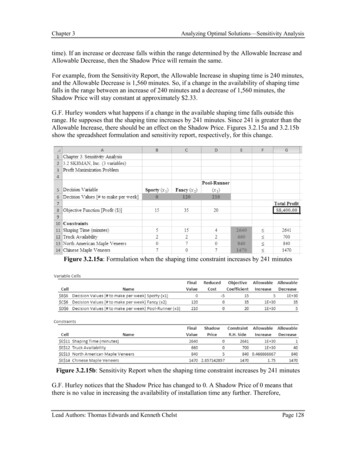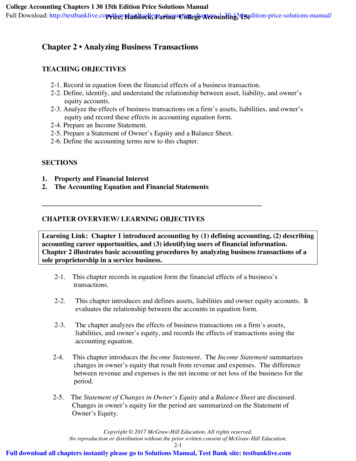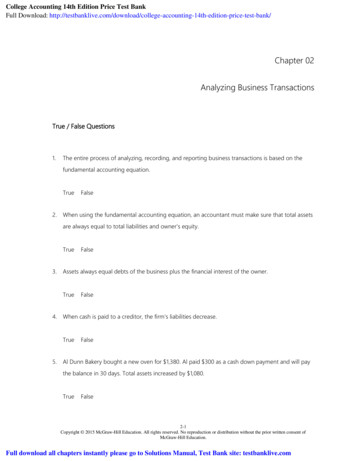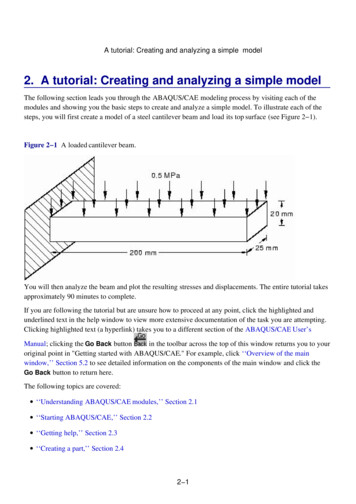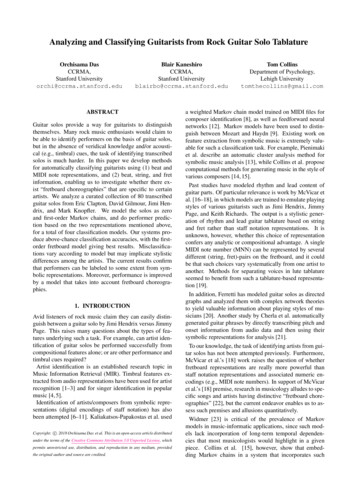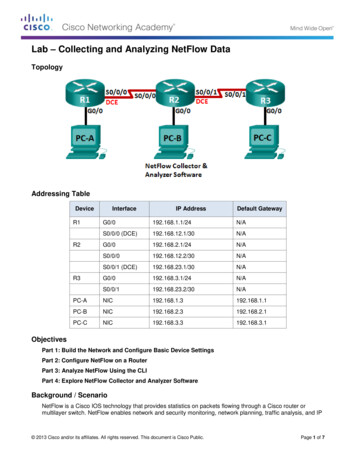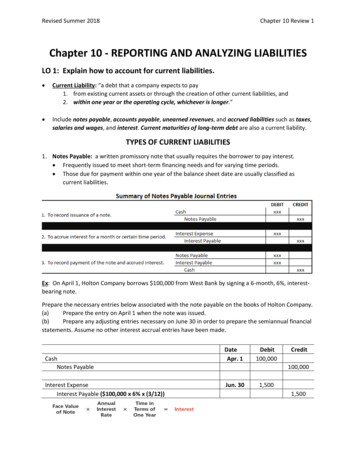
Transcription
Revised Summer 2018Chapter 10 Review 1Chapter 10 - REPORTING AND ANALYZING LIABILITIESLO 1: Explain how to account for current liabilities. Current Liability: “a debt that a company expects to pay1. from existing current assets or through the creation of other current liabilities, and2. within one year or the operating cycle, whichever is longer.” Include notes payable, accounts payable, unearned revenues, and accrued liabilities such as taxes,salaries and wages, and interest. Current maturities of long-term debt are also a current liability.TYPES OF CURRENT LIABILITIES1. Notes Payable: a written promissory note that usually requires the borrower to pay interest. Frequently issued to meet short-term financing needs and for varying time periods. Those due for payment within one year of the balance sheet date are usually classified ascurrent liabilities.Ex: On April 1, Holton Company borrows 100,000 from West Bank by signing a 6-month, 6%, interestbearing note.Prepare the necessary entries below associated with the note payable on the books of Holton Company.(a)Prepare the entry on April 1 when the note was issued.(b)Prepare any adjusting entries necessary on June 30 in order to prepare the semiannual financialstatements. Assume no other interest accrual entries have been made.CashNotes PayableInterest ExpenseInterest Payable ( 100,000 x 6% x (3/12))DateApr. 1Debit100,000Credit100,000Jun. 301,5001,500
Revised Summer 2018Chapter 10 Review 22. Sales Taxes Payable: sales taxes that have to be paid to the government. Sales taxes are expressed as a stated percentage of the sales price.The selling company collects the tax from the customer and then remits the collectionsto the state’s department of revenue (usually monthly.)Ex 1: On May 28 cash register readings for Holton Company shows sales of 20,000 and sales taxes of 2,000 (sales tax rate of 2% x 20,000). The journal entry isCashSales RevenueSales Taxes Payable ( 20,000 x 2%)DateMay 28Debit22,000Credit20,0002,000Ex 2: On May 28 Holton Company rings up total receipts of 22,000. The amount received includes a taxon 10% of sales. The journal entry isCashSales Revenue ( 22,000 1.10)Sales Taxes Payable ( 22,000 - 20,000)DateMay 28Debit22,000Credit20,0002,0003. Unearned Revenue: cash that is received BEFORE goods are delivered or services are performed. Current liability on the balance sheet.
Revised Summer 2018Chapter 10 Review 3Ex: Intelligent University sells 20,000 season football tickets at 30 each for its 8-game home scheduleon August 1. The entry for the sales of season tickets is:CashUnearned Ticket Revenue (20,000 x 30)DateAug. 1Debit600,000Credit600,000On Aug. 28, the first home game for Intelligent University was completed. Intelligent University recordsthe earning of revenue with the following journal entry.Unearned Ticket RevenueTicket Revenue ( 60,000 8 games)DateAug. 28Debit75,0004. Payroll and Payroll Taxes Payable: Payroll pertains to both:1. Salaries - managerial, administrative, and sales personnel (monthly or yearly rate).2. Wages - store clerks, factory employees, and manual laborers (rate per hour). Gross Pay – Payroll Deductions Net Pay (What the employee takes home)Payroll deductions include:1. Insurance, pensions, and/or union dues2. FICA Taxes (Social Security and Medicare)3. Federal Income Tax4. State and City Income Taxes5. CharityCredit75,000
Revised Summer 2018Chapter 10 Review 4 In addition to withholding taxes from their employees to remit to the government, employers haveto pay payroll taxes. Payroll taxes include FICA Tax, Federal Unemployment Tax, and State Unemployment Tax.Ex: During the month of March, Preston Company's employees earned wages of 90,000. Withholdingsrelated to these wages were 6,885 for Social Security (FICA), 14,200 for federal income tax, and 6,200 for state income tax. The company incurred no cost related to these earnings for federalunemployment tax, but incurred 1,300 for state unemployment tax.(a)Prepare the necessary March 31 journal entry to record wages expense and wages payable.Assume that wages earned during March will be paid during April.Salaries and Wages ExpenseFICA Taxes PayableFederal Income Taxes PayableState Income Taxes PayableSalaries and Wages Payable(b)DateMar. 31Debit90,000Credit6,88514,2006,20062,715Prepare the entry to record the company's payroll tax expense.Payroll ExpenseFICA Taxes PayableState Unemployment Taxes PayableDateMar. 31Debit8,185Credit6,8851,300
Revised Summer 2018Chapter 10 Review 5LO 2: Describe the major characteristics of bonds. Long-term Liabilities: “Obligations that a company expects to pay MORE THAN ONE YEAR in thefuture.”BONDS “a form of interest-bearing notes payable issued by corporations, universities, and governmentalagencies.”Sold in small denominations (usually 1,000 or multiples of 1,000).When a corporation issues bonds, it is borrowing money. The person who buys the bonds (thebondholder) is investing in bonds.*** BOND ISSUANCE RESULTS IN CASH GOING UP BECAUSE THE COMPANY ISSUING THE BOND ISBORROWING MONEY.TYPES OF BONDS1.2.3.4.Secured bonds: have specific assets of the issuer pledged as collateral for the bonds.Unsecured bonds: are issued against the general credit of the borrower.Convertible bonds: can be converted into common stock at the bondholder’s option.Callable bonds: can be redeemed (bought back), by the issuing company, at a stated dollar amountprior to maturity.ISSUING BONDS Bond Certificate: issued to the investor and provides the name of the company issuing bonds, facevalue, maturity date, and contractual (stated) interest rate. Face Value: principal due at the maturity. Maturity Date: date final payment is due to the investor from the issuing company. Contractual Interest Rate: rate to determine cash interest paid. It is stated as an annual rate.
Revised Summer 2018 Chapter 10 Review 6The current market price (present value) of a bond is a function of three factors:1. The dollar amounts to be received.2. The length of time until the amounts are received.3. The market rate of interest (the rate investors demand for loaning funds.)Time value of money: a dollar received today is worth more than a dollar promised at some time inthe future.The current market price of a bond is equal to the present value of all future cash paymentspromised by the bond.Ex: Assume that Meteor Company on January 1, 20X1, issues 100,000 of 9% bonds, due in five years,with interest payable annually at year-end. Meteor company has to pay 9,000 ( 100,000 x 9%) at the END of each year for the next 5 yearsin addition to the 100,000 that it has to pay back at the end of 5 years.The market price of the bonds would factor in the 5 interest payments of 9,000 and thepayment of the face amount in 5 years.
Revised Summer 2018Chapter 10 Review 7LO 3: Explain how to account for bond transactions. A corporation records bond transactions when it issues (sells) or redeems (buys back) bonds andwhen bondholders convert bonds into common stock.Bonds may be issued at 1. Face Value2. Below Face Value (Discount)3. Above Face Value (Premium)Key Relationship between Contract Rate (SET BY BOND), Market Rate (SET BY MARKET), and BondPrice. The journal entries for the issuance of the bonds are recorded below.Contractual interest rate rate applied to the face value (par) to arrive at the interest paid for ayear.Market interest rate rate investors demand for loaning funds to the corporation.1. Market Rate Contract RateBonds issued at Face Value.DateCashDebitXXXBonds Payable2. Market Rate (GREATER THAN) Contract RateXXXDiscount (Bonds less than Face Value)DateCashDiscount on Bonds PayableBonds Payable3. Market Rate (LESS THAN) Contract Rate DebitXXXXXXCreditXXXPremium (Bonds more than Face Value)DateCashBonds PayablePremium on Bonds PayableCreditDebitXXXCreditXXXXXXBond prices are quoted as a percentage of face value.1. Bonds quoted BELOW 100 are offered at a DISCOUNT. If a 1,000 bond is offered at96 (96% of face value), the selling price of the bond is 960 ( 1,000 .96)2. Bonds quoted ABOVE 100 are offered at a PREMIUM. If a 1,000 bond is offered at102 (102% of face vale), the selling price of the bond is 1,020 ( 1,000 1.02)3. Bonds quoted AT 100 are offered at FACE VALUE. If a 1,000 bond is offered at 100(100% of face value), the selling price of the bond is 1,000 ( 1,000 1.00)
Revised Summer 2018Chapter 10 Review 8ISSUING BONDS AT FACE Occurs when MARKET RATE CONTRACT RATE or bonds are quoted at 100.Ex: (A) Denver Corporation issues 100, five-year, 10%, 1,000 bonds dated January 1, 20X1, at 100(100% of face value). The entry to record the sale is:CashBonds Payable (100 1,000)DateJan. 120X1Debit100,000Credit100,000(B) Prepare the entry Denver would make to accrue interest on December 31.Interest ExpenseInterest Payable ( 100,000 x 10% x 12/12)DateDec. 3120X1Debit10,000Credit10,000(C) Prepare the entry Denver would make to pay the interest on Jan. 1, 20X2.Interest ExpenseInterest Payable ( 100,000 x 10% x 12/12)DateJan. 120X2Debit10,000Credit10,000ISSUING BONDS AT A DISCOUNT Occurs when MARKET RATE CONTRACT RATE or bonds are quoted BELOW 100.Ex: Denver Corporation issues 100, five-year, 10%, 1,000 bonds dated January 1, 20X1, at 98(98%of face value) with interest payable January 1. The entry to record the sale is:Cash (100 1,000 0.98)Discount on Bonds PayableBonds Payable (100 1,000) DateJan. 120X1Debit98,0002,000Credit100,000Sale of bonds below face value causes the total cost of borrowing to be more than the bondinterest paid.The issuing corporation not only must pay the contractual interest rate over the term of the bondsbut also must pay the face value (rather than the issuance price) at maturity.
Revised Summer 2018 Chapter 10 Review 9Discount on Bonds Payable is acontra account that is deductedfrom bonds payable on thebalance sheet.ISSUING BONDS AT A PREMIUM Occurs when MARKET RATE CONTRACT RATE or bonds are quoted ABOVE 100.Ex: Denver Corporation issues 100, five-year, 10%, 1,000 bonds dated January 1, 20X1, at102(102% of face value) with interest payable January 1. The entry to record the sale is:Cash (100 1,000 1.02)Bonds Payable (100 1,000)Premium on Bonds Payable DateJan. 120X1Debit102,000Credit100,0002,000Sale of bonds above face value causes the total cost of borrowing to be less than the bond interestpaid.The borrower is not required to pay the bond premium at the maturity date of the bonds. Thus, thebond premium is considered to be a reduction in the cost of borrowing.Premium on Bonds Payable isadded to bonds payable on thebalance sheet.
Revised Summer 2018Chapter 10 Review 10LO 5: Apply the straight-line method of amortizing bond discount and bondpremium.AMORTIZATION OF BOND DISCOUNT Allocated to expense in each period.INCREASES the amount of interest expense reported each period.Amount of interest expense reported each period will exceed the contractual amount paid.As the discount is amortized, its balance declines.The carrying value of the bonds will increase, until at maturity the carrying value of the bondsequals their face amount.Interest Expense Interest Paid (Par Value X Contract Interest Rate) Amortized Discount on Bonds Payable Bond discount must be reduced and ADDED to interest expense to reflect the passage of time. Thisprocess INCREASES the contract rate of interest on a bond to the market rate of interest that existedon the date the bonds was issued.BOND DISCOUNT NUMBER OFINTEREST PERIODS BOND DISCOUNTAMORTIZATIONPrevious Example: (A) Denver Corporation issues 100, five-year, 10%, 1,000 bonds dated January1, 20X1, at 98(98% of face value) with interest payable January 1. The entry to record the sale is:Cash (100 1,000 0.98)Discount on Bonds PayableBonds Payable (100 1,000)DateJan. 120X1Debit98,0002,000Credit100,000(B) Prepare the entry to accrue interest and amortize the bond discount at Dec. 31, 20X1.Step 1: Bond Discount Amortization Bond Discount Number of Interest PeriodsBond Discount Amortization 2,000 5 years 400 per yearStep 2: Interest Payable Face Value Contractual RateInterest Payable 100,000 10% 10,000Step 3:Interest Expense Interest to be Paid Amortized Discount on Bonds PayableInterest Expense 10,000 400 10,400Interest ExpenseDiscount on Bonds PayableInterest PayableDateDec. 3120X1Debit10,400Credit40010,000
Revised Summer 2018Chapter 10 Review 11*Each year the same journal entrywould be made. The discountamortization, interest expense, andinterest to be paid remain the sameeach year.AMORTIZATION OF BOND PREMIUM Allocated to expense in each period.DECREASES the amount of interest expense reported each period.Amount of interest expense reported each period will be less than the contractual amount paid.As the premium is amortized, its balance declines.The carrying value of the bonds will decrease, until at maturity the carrying value of the bondsequals their face amount.Interest Expense Interest Paid (Par Value X Contract Interest Rate) - Amortized Premium on Bonds Payable The amortization of a bond premium DECREASES the contract rate of interest on a bond to themarket rate of interest that existed on the date the bonds were issuedBOND PREMIUM NUMBER OFINTEREST PERIODS BOND PREMIUMAMORTIZATIONPrevious Example: (A) Denver Corporation issues 100, five-year, 10%, 1,000 bonds dated January1, 20X1, at 102(102% of face value) with interest payable January 1. The entry to record the sale is:Cash (100 1,000 1.02)Bonds Payable (100 1,000)Premium on Bonds PayableDateJan. 120X1Debit102,000(B) Prepare the entry to accrue interest and amortize the bond premium at Dec. 31, 20X1.Step 1: Bond Premium Amortization Bond Premium Number of Interest PeriodsBond Premium Amortization 2,000 5 years 400 per yearStep 2: Interest Payable Face Value Contractual RateInterest Payable 100,
Discount on Bonds Payable is a contra account that is deducted from bonds payable on the balance sheet. ISSUING BONDS AT A PREMIUM Occurs when MARKET RATE CONTRACT RATE or bonds are quoted ABOVE 100. Ex: Denver Corporation issues 100, five-year, 10%, 1,000 bonds dated January 1,
